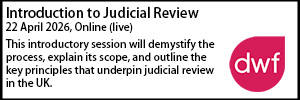- Details
Apply key section of Equality Act to improve judicial diversity, say peers
Peers have called for a key part of the Equality Act 2010 to be applied to judicial appointments in a bid to create a more diverse judiciary.
In a report published this week the House of Lords Constitution Committee acknowledged that appointment based on merit was vital and should continue.
But the peers added that s. 159 of the 2010 Act would “allow the desire to encourage diversity to be a relevant factor where two candidates are found to be of equal merit”.
Arguing that a more diverse judiciary would improve public trust and confidence in the justice system, the committee also recommended that:
- The Lord Chancellor and Lord Chief Justice should be placed under a duty to encourage diversity amongst the judiciary. This is already the case for the Judicial Appointments Committee (JAC);
- There should be a greater commitment on the part of the Government, the judiciary and the legal professions to encourage applications for the judiciary from lawyers other than barristers. “Being a good barrister is not necessarily the same thing as being a good judge”, the report said;
- The introduction of targets for the number of Black, Asian and Minority Ethnic (BAME) and women judges should be looked at again in five years “if significant progress has not been made”;
- The Lord Chancellor’s role in individual appointments should be limited. The power to reject nominations for posts below the High Court should be transferred to the Lord Chief Justice;
- A system of formal appraisals for judges should be introduced;
- The retirement age for the most senior judges – in the Supreme Court and the Court of Appeal – should be raised to 75. The age for all other judges should stay at 70.
The committee ruled out suggestions that judicial candidates should be subject to US-style pre- or post-appointment parliamentary hearings.
“Political considerations would undoubtedly influence both the parliamentarians chosen to sit on the panels and the questions put to candidates,” it said.
The report cited statistics showing that in 2011 only 5.1% of judges were BAME and just 22.3% were women.
Baroness Jay, a member of the Constitution Committee, said: “It is vital that the public have confidence in our judiciary. One aspect of ensuring that confidence is a more diverse judiciary that more fully reflects the wider population. That even by 2011 only 5% of judges were from minority groups and only 22% were women suggest there is still work to be done in this area.”
She added that support for flexible working within the judiciary would be a good start to encouraging diversity.
“It is also important that solicitors, who are a more representative group of society than barristers, do not face any impediments to a career in the judiciary,” the Baroness added.
JAC Chairman Christopher Stephens said judicial diversity was increasing but faster progress would take “concerted and innovative action” from many different bodies, including the legal professions and the judiciary itself.
He added: “I am pleased to see the Committee recommend extending opportunities for flexible working and career breaks and increasing judicial appraisal. We have already planned to review the new protocol agreed with the senior judiciary for designating Deputy High Court judges and will do so within three years. The JAC is also considering how section 159 of the Equality Act could work in practice.”
Legal Director - Government and Public Sector
Solicitor/Lawyer (Contracts and Procurement)
Deputy Director Legal and Democratic Services
Antisocial Behaviour Legal Officer
Regulatory/Litigation Lawyer
Solicitor - Litigation
Contracts Lawyer
Legal Adviser
Governance Lawyer
Lawyer (Planning and Regulatory)
Locum roles
 Masterclass – MCA and Court of Protection - Legal Update - Peter Edwards Law Training
Masterclass – MCA and Court of Protection - Legal Update - Peter Edwards Law Training
21-01-2026
Online (live)
 Managing settlements: the legal and practical issues, and the pitfalls to avoid - Blake Morgan
Managing settlements: the legal and practical issues, and the pitfalls to avoid - Blake Morgan
22-01-2026 10:00 am
Online (live)
 Children and Young People (DoL, Competency and Capacity) - Peter Edwards Law Training
Children and Young People (DoL, Competency and Capacity) - Peter Edwards Law Training
28-01-2026
Online (live)
 HMPL Building Blocks: Legal Tools to Combat Anti-Social Behaviour - Devonshires
HMPL Building Blocks: Legal Tools to Combat Anti-Social Behaviour - Devonshires
17-02-2026
Online (live)
 Freedom of thought, belief and religion: Article 9 ECHR - Francis Taylor Building
Freedom of thought, belief and religion: Article 9 ECHR - Francis Taylor Building
19-02-2026
Online (live)
 Grappling with S73 - variations of conditions applications or appeals - Ivy Legal
Grappling with S73 - variations of conditions applications or appeals - Ivy Legal
09-03-2026
Online (live)
 HMPL Building Blocks: Tenancy Management – Assignment, Mutual Exchange and Succession - Devonshires
HMPL Building Blocks: Tenancy Management – Assignment, Mutual Exchange and Succession - Devonshires
12-03-2026
Online (live)
 Section 31(2A) Senior Courts Act: where have we got to? - Francis Taylor Building
Section 31(2A) Senior Courts Act: where have we got to? - Francis Taylor Building
18-03-2026 1:00 pm
Online (live)
 Save the Date: The Law of Public Rights of Way, Commons and Town or Village Greens Seminar (Hybrid) - Francis Taylor Building
Save the Date: The Law of Public Rights of Way, Commons and Town or Village Greens Seminar (Hybrid) - Francis Taylor Building
25-03-2026
London
 HMPL Building Blocks: A Housing Officer’s Guide to Court Proceedings - Devonshires
HMPL Building Blocks: A Housing Officer’s Guide to Court Proceedings - Devonshires
14-04-2026
Online (live)




























































































































 First Aid Level 3 - LBL Skills
First Aid Level 3 - LBL Skills  Capsticks Housing Diploma
Capsticks Housing Diploma  Standish 18 months on - 42BR
Standish 18 months on - 42BR  Accelerating EV Charging Infrastructure in the Public Sector - DWF
Accelerating EV Charging Infrastructure in the Public Sector - DWF  Building Safety Act Conference 2026 - Landmark Chambers
Building Safety Act Conference 2026 - Landmark Chambers  Education Law Conference - 3PB
Education Law Conference - 3PB  Annual Planning Seminar 2026 - No.5 Barristers
Annual Planning Seminar 2026 - No.5 Barristers 